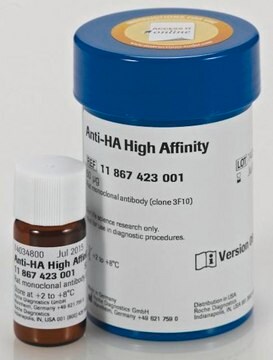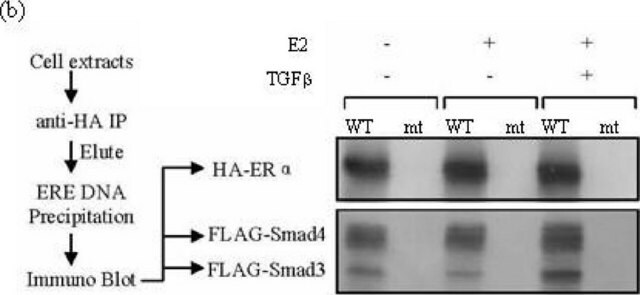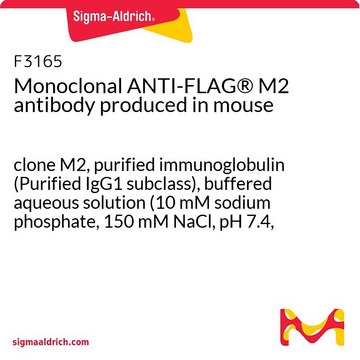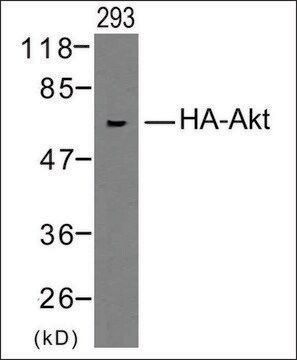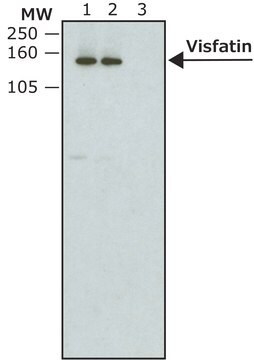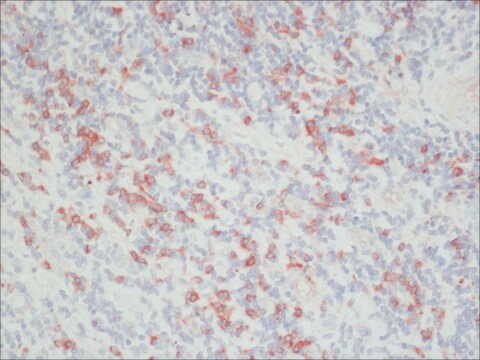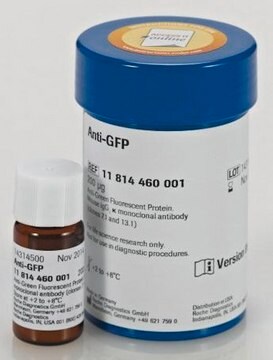12013819001
Roche
Anti-HA-Peroxidase, High Affinity
from rat IgG1
Sinónimos:
antibody
Iniciar sesiónpara Ver la Fijación de precios por contrato y de la organización
About This Item
UNSPSC Code:
12352203
Productos recomendados
biological source
rat
Quality Level
conjugate
peroxidase conjugate
antibody form
purified immunoglobulin
antibody product type
primary antibodies
clone
clone 3F10, monoclonal
form
lyophilized (clear, colorless solution after reconstitution)
packaging
pkg of 25 U (25 μg)
manufacturer/tradename
Roche
isotype
IgG1
epitope sequence
YPYDVPDYA
storage temp.
2-8°C
Categorías relacionadas
General description
Anti-HA-Peroxidase, High Affinity is a monoclonal antibody to the HA-peptide (clone 3F10), conjugated to peroxidase.
Specificity
Anti-HA-Peroxidase, High Affinity (3F10) recognizes the 9-amino acid sequence YPYDVPDYA, derived from the human influenza hemagglutinin (HA) protein.
This epitope is also recognized in fusion proteins regardless of its position (N-terminal, C-terminal or internal).
This epitope is also recognized in fusion proteins regardless of its position (N-terminal, C-terminal or internal).
Immunogen
The epitope consists of amino acids 98-106 from the human influenza virus hemagglutinin protein.
Application
- Use Anti-HA-Peroxidase, High Affinity for the detection of HA-tagged recombinant proteins using: ELISA
- Western blot
Preparation Note
Stabilizers: proteinaceous stabilizers
Working concentration: The working concentration of conjugate depends on application and substrate.
The following concentrations should be taken as a guideline:
Working concentration: The working concentration of conjugate depends on application and substrate.
The following concentrations should be taken as a guideline:
- Dot blot: 50 mU/ml
- ELISA: 25 mU/ml
- Western blot: 50 mU/ml
Reconstitution
Add 1.0 ml double-distilled water for a final concentration of 25 U/mL.
Rehydrate for 10 min prior to use.
Rehydrate for 10 min prior to use.
Other Notes
For life science research only. Not for use in diagnostic procedures.
¿No encuentra el producto adecuado?
Pruebe nuestro Herramienta de selección de productos.
signalword
Warning
hcodes
Hazard Classifications
Skin Sens. 1
Storage Class
11 - Combustible Solids
wgk_germany
WGK 1
flash_point_f
does not flash
flash_point_c
does not flash
Elija entre una de las versiones más recientes:
¿Ya tiene este producto?
Encuentre la documentación para los productos que ha comprado recientemente en la Biblioteca de documentos.
Los clientes también vieron
Asim A Beg et al.
Neuron, 55(5), 768-778 (2007-09-06)
The assembly of neuronal networks during development requires tightly controlled cell-cell interactions. Multiple cell surface receptors that control axon guidance and synapse maturation have been identified. However, the signaling mechanisms downstream of these receptors have remained unclear. Receptor signals might
Rokusuke Yoshikawa et al.
Microbiology and immunology, 60(6), 427-436 (2016-05-20)
Mammals have co-evolved with retroviruses, including lentiviruses, over a long period. Evidence supporting this contention is that viral infectivity factor (Vif) encoded by lentiviruses antagonizes the anti-viral action of cellular apolipoprotein B mRNA editing enzyme catalytic polypeptide-like 3 (APOBEC3) of
Jochen Klucken et al.
FASEB journal : official publication of the Federation of American Societies for Experimental Biology, 20(12), 2050-2057 (2006-10-03)
Oligomerization and aggregation of alpha-synuclein molecules are believed to play a major role in neuronal dysfunction and loss in Parkinson's disease (PD) and dementia with Lewy bodies. However, alpha-synuclein oligomerization and aggregation have been detected only indirectly in cells using
Michael Röring et al.
The EMBO journal, 31(11), 2629-2647 (2012-04-19)
The dimerisation of Raf kinases involves a central cluster within the kinase domain, the dimer interface (DIF). Yet, the importance of the DIF for the signalling potential of wild-type B-Raf (B-Raf(wt)) and its oncogenic counterparts remains unknown. Here, we show
Regina Gratz et al.
The New phytologist, 225(1), 250-267 (2019-09-06)
The key basic helix-loop-helix (bHLH) transcription factor in iron (Fe) uptake, FER-LIKE IRON DEFICIENCY-INDUCED TRANSCRIPTION FACTOR (FIT), is controlled by multiple signaling pathways, important to adjust Fe acquisition to growth and environmental constraints. FIT protein exists in active and inactive
Nuestro equipo de científicos tiene experiencia en todas las áreas de investigación: Ciencias de la vida, Ciencia de los materiales, Síntesis química, Cromatografía, Analítica y muchas otras.
Póngase en contacto con el Servicio técnico